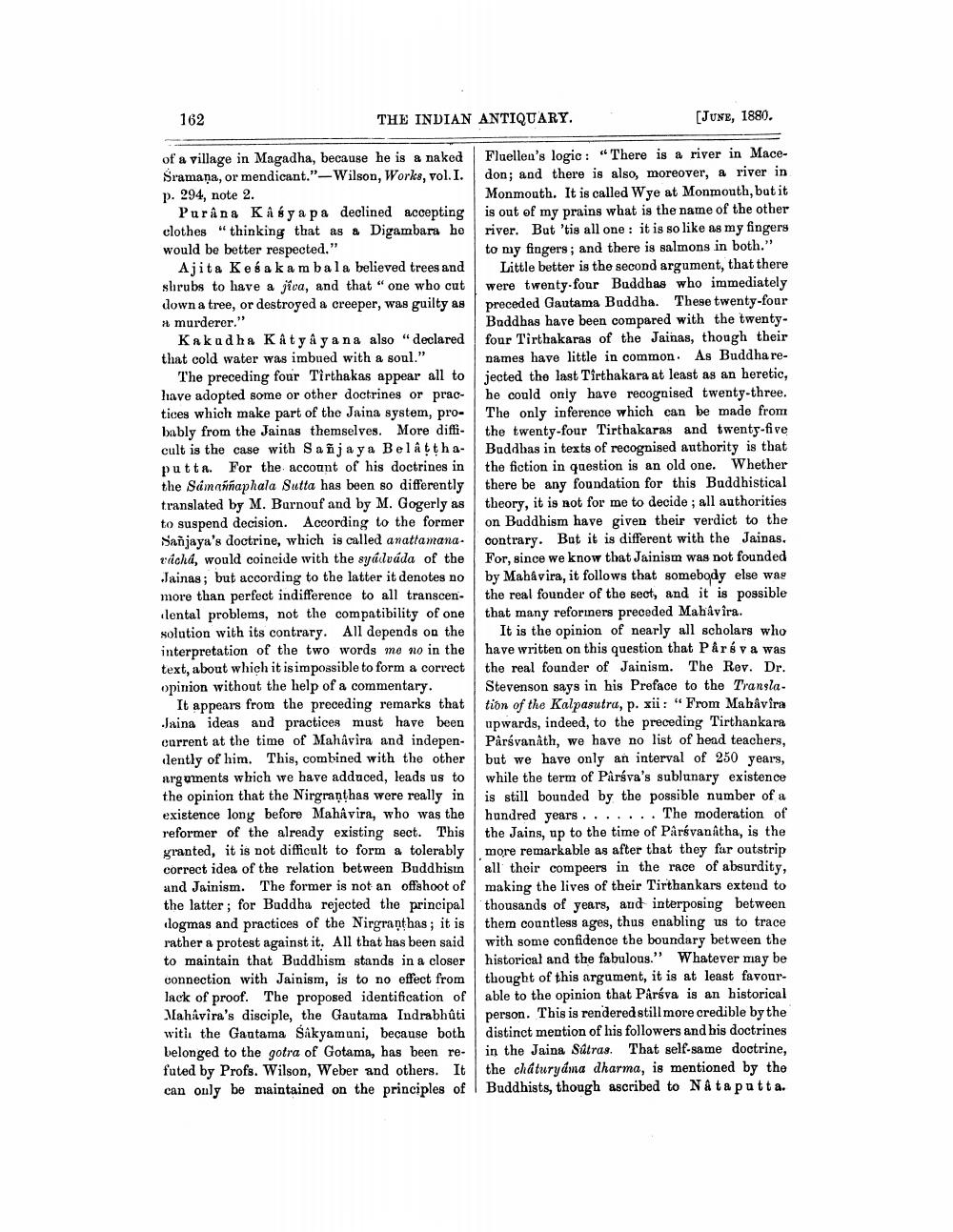________________
162
THE INDIAN ANTIQUARY.
[JUNE, 1880.
of a village in Magadha, because he is a naked Sramaņa, or mendicant."-Wilson, Works, vol. I. p. 294, note 2.
Purana Ků sya pa declined accepting clothes " thinking that as a Digambara ho would be better respected."
Ajita Kesaka mbala believed trees and shrubs to have a jiva, and that one who cut down a tree, or destroyed a creeper, was guilty as a murderer."
Kakudha Katya yana also "declared that cold water was imbued with a soul."
The preceding four Tirthakas appear all to have adopted some or other doctrines or practices which make part of the Jaina system, probably from the Jainas themselves. More difficult is the case with Sañjaya Belåtthaputta. For the account of his doctrines in the Sámaññaphala Sutta has been so differently translated by M. Barnouf and by M. Gogerly as to suspend decision. According to the former Sanjaya's doctrine, which is called anattamana. vich, would coincide with the syállváda of the Jainas; but according to the latter it denotes no more than perfect indifference to all transcen.
lental problems, not the compatibility of one solution with its contrary. All depends on the interpretation of the two words me no in the text, about which it isimpossible to form a correct opinion without the help of a commentary.
It appears from the preceding remarks that Jaina ideas and practices must have been current at the time of Mahavira and indepen. dently of him. This, combined with the other arguments which we have adduced, leads us to the opinion that the Nirgranthas were really in existence long before Mahîvira, who was the reformer of the already existing sect. This yranted, it is not difficult to form a tolerably correct idea of the relation between Buddhism and Jainism. The former is not an offshoot of the latter; for Buddha rejected the principal clogmas and practices of the Nirgranthas; it is rather a protest against it. All that has been said to maintain that Buddhism stands in a closer connection with Jainism, is to no effect from lack of proof. The proposed identification of Mahavira's disciple, the Gautama Indrabhûti with the Gautama Sakyamuni, because both belonged to the gotra of Gotama, has been re- futed by Profs. Wilson, Weber and others. It can only be maintained on the principles of
Fluellea's logic: “There is a river in Macedon; and there is also, moreover, a river in Monmouth. It is called Wye at Monmouth, but it is out of my prains what is the name of the other river. But 'tis all one : it is so like as my fingers to my fingers; and there is salmons in both."
Little better is the second argument, that there were twenty.four Buddhas who immediately preceded Gautama Buddha. These twenty-four Buddhas have been compared with the twentyfour Tirthakaras of the Jainas, though their names have little in common. As Buddha rejected the last Tirthakara at least as an heretic, he could only have recognised twenty-three. The only inference which can be made from the twenty-four Tirthakaras and twenty-five Buddhas in texts of recognised authority is that the fiction in question is an old one. Whether there be any foundation for this Buddhistical theory, it is not for me to decide; all authorities on Buddhism have given their verdict to the contrary. But it is different with the Jainas. For, since we know that Jainism was not founded by Mahavira, it follows that somebody else wag the real founder of the sect, and it is possible that many refortners preceded Mahavira.
It is the opinion of nearly all scholars who have written on this question that Pårøv a was the real founder of Jainism. The Rev. Dr. Stevenson says in his Preface to the Transla. tion of the Kalpasutra, p. xii: "From Mahavira upwards, indeed, to the preceding Tirthankara Parsvanath, we have no list of head teachers, but we have only an interval of 250 years, while the term of Paráva's sublunary existence is still bounded by the possible number of a hundred years . . . . . . . The moderation of the Jains, up to the time of Parsvanatha, is the more remarkable as after that they far outstrip all their compeers in the race of absurdity, making the lives of their Tirthankars extend to thousands of years, and interposing between them countless ages, thus enabling us to trace with some confidence the boundary between the historical and the fabulous." Whatever may be thought of this argument, it is at least favourable to the opinion that Parsva is an historical person. This is rendered still more credible by the distinct mention of his followers and his doctrines in the Jaina Sátras. That self-same doctrine, the cháturyáma dharma, is mentioned by the Buddhists, though ascribed to Nataputta.




